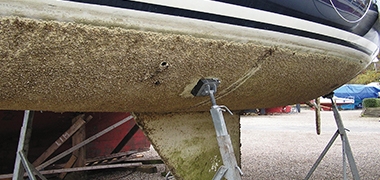Hull Fouling
What is it and how do I solve this?
This is when fouling grows on underwater areas earlier than expected. It can happen because you haven’t used the correct antifouling strength for the waters your boat is moored in or navigating and for a variety of other reasons as listed.
How to recognize it

Stubborn fouling that is hard to remove. It is not the soft slime type material that is easily washed away. Antifouling paint may show signs of being badly discolored with black patches or a bleaching effect on color. You might also find that antifouling turns sticky around the waterline.
Cause - Prevention - Treatment
Cause 1: Insufficient amount of paint applied.
Prevention: The number of coats applied is not the important factor, it is the total volume of paint applied that is important. If it takes more than the stated number of coats to apply the correct quantity then do so.
Treatment: Apply correct amount of paint.
Cause 2: A vessel left on the hard stand for a longer period will be affected by heat and sunlight. This leads to mild oxidization of the surface. It could also be affected by automotive exhaust fumes, overspray of paint and wind-blown contamination settling into the paint as it dries.
Prevention: Do not exceed the maximum immersion time for the antifouling as stated on the datasheet.
Treatment: Remove any fouling, wet sand and if possible high pressure fresh water wash, to reactivate surface.
Cause 3: Antifouling paint can settle out during storage in the can. This settlement can contain a significant portion of the biocide. In extreme cases the active material may be left undisturbed in the bottom of the can and discarded with it inside.
Prevention: Stir paint thoroughly before use.
Treatment: Reapplying new antifouling is the only option.
Cause 4: Once antifoulings are immersed they require a short period to start working. A newly painted vessel if launched and/or moored in an area where there is unusually high fouling activity may foul prematurely. This usually occurs with barnacle spats and since they develop at a fast rate, they might appear as small white dots that progressively get larger even after a couple of weeks.
Prevention: No preventative solution exists other than moving vessel to another location..
Treatment: Remove all fouling, wet sand and if possible high pressure fresh water wash to reactivate the surface.
Cause 5: Heavy rainfall can reduce the salinity of the sea water. This may reduce the ability of some ablative/eroding antifoulings to erode or leach out the biocide for a period of time until the water has reverted back to its normal salinity levels.
Prevention: Unfortunately, there’s nothing you can do to change the course of nature.
Treatment: Remove all fouling, wet sand and if possible high pressure fresh water wash to reactivate surface.
Cause 6: Outfalls from the land, through discharge pipes or by natural flow over the ground, can contain any number of chemicals such as phosphates / sulfates from fertilizers, leach-out from old landfills, and more. All of them can seriously affect antifouling paint.
Prevention: No preventative solution exists other than moving vessel to another location.
Treatment: Remove all fouling, wet sand and if possible high pressure fresh water wash to reactivate surface.
Cause 7: Heavy rain or higher than normal sea temperatures can stir up nutrients from the sea floor and lead to increased levels of available food. This results in a higher density of fouling species and consequently a higher fouling challenge for the paint. In severe cases the paint can be totally overcome by such a challenge.
Prevention: Unfortunately, there’s nothing you can do to change the course of nature.
Treatment: Removing all fouling, wet sand and if possible high pressure fresh water wash to thoroughly clean the antifouling.
Cause 8: Vessels left sitting unused for extended periods can become clogged when storms stir up mud and silt. The clogging results in the paint being unable to erode away and/or release its biocide package at the correct rate.
Prevention: Use your boat more often or after such an event and/or wash it down lightly.
Treatment: Removing all fouling, wet sand and if possible high pressure fresh water wash to thoroughly clean the antifouling.
Cause 9: If the hull is washed too hard too often it can deplete the film build to a level where there isn’t enough to resist growth. This usually occurs around the waterline.
Prevention: Use softer washing equipment.
Treatment: Re-consider choice of antifouling paint ie use a harder type product.
Cause 10: The wrong cathodic protection on metal hulls can lead to copper based antifoulings not leaching the copper correctly.
Prevention: Correct the level of protection fitted to hull.
Treatment: Wet sand and if possible high pressure fresh water wash to reactivate surface
Paint your boat like a pro
Find the best products to keep your boat in great condition
Get all the support you need to paint with confidence
Benefit from our continuous innovation and scientific expertise






